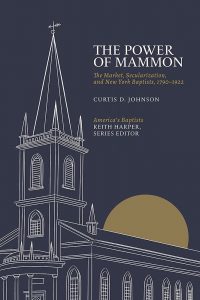Baptists and other Christians must resist economic trends that diminish the moral and spiritual influence of Christianity in an increasingly secular American society, historian Curtis Johnson warned during a webinar presented by the Baptist History and Heritage Society.
“We live prosperous lives. We live longer and better than we ever would without the market,” Johnson said. “But at what point does the market become adversarial to our Christian faith? It’s kind of like the market likes to creep up … and bump Christianity down a few notches and become primary in people’s lives.”

Curtis Johnson
Johnson is a history professor at Mount St. Mary’s University in Emmitsburg, Md., and author of The Power of Mammon: The Market, Secularization and New York Baptists, 1790-1922. He presented findings from his book in the latest episode of the history society’s “Making Baptist History Public History” webinar series.
The experience of New York Baptists during the period covered in the book speaks to the modern church as it endures declining membership and the rise of the nones — people who claim no religious affiliation, Johnson said.
“There have been numerous surveys showing that Christianity seems to be in decline in terms of the general public, and it is particularly strong among Generation Z,” he said of Americans roughly between 12 and 25 years old. “Gen Z is the future, and so it’s kind of like, wow, why is this happening?
Discouraging trend
“As a Christian, I find this discouraging. And as a historian, I also kind of like to figure out what’s going on.”
“As a Christian, I find this discouraging. And as a historian, I also kind of like to figure out what’s going on.”
Some of the answer lies in the records of New York Baptist churches and associations dating back to the late 18th century, Johnson said, noting, “At least in New York, it appears the process of secularization began about 200 years ago.”
Baptist churches in New York began this period largely as “covenant meetings” that consisted of prayer gatherings, spiritual sharing and renewing communal vows between themselves and God.
“In many churches, women played a role in church governance, and the church property tax (paid by members) was a common thing,” he said. “And they cared for their impoverished members.”
Most churches were governed by “strict laity rule” that included disciplining members and clergy alike — although having ministers was uncommon.
“Congregations had to be self-reliant, because during much of this early time, there simply weren’t enough Baptist clergymen in New York state to meet the growing needs of the huge numbers of people who were migrating” to the western part of the state, Johnson said. “By the time you get to 1812, basically one-third of Baptist churches had no clergymen. But they survived because the covenant meetings kept them together.”
“Awakenings” and survival
“Awakenings” — spontaneous lay-led house-to-house evangelistic campaigns that preceded the advent of the revival meeting and contributed to high baptism rates — also helped ensure survival, he added.
 “The church … was the chief human agency connected with these manifestations of divine grace” and, as a result, “the number of Baptist churches and the number of Baptist members grew rapidly,” he said.
“The church … was the chief human agency connected with these manifestations of divine grace” and, as a result, “the number of Baptist churches and the number of Baptist members grew rapidly,” he said.
But the opening of the Erie Canal in 1825 and the financial transformation it generated spelled the eventual end of communal lay-led Baptist Christianity in New York, Johnson said.
“What the market revolution does is it turns everything upside down. … It changes the entire economy of New York state,” he said. It also changed attitudes about the authority and social relevance of the church among New York Baptists, as professional and financial standing became central in people’s lives, he said.
“… the growth of a market economy undermined tradition, changed values and captured most people’s attention with an array of products, amusements and other distractions …”
“While several factors played a role in the secularization of New York’s Baptist churches, the key element was the growth of a market economy that undermined tradition, changed values and captured most people’s attention with an array of products, amusements and other distractions that turned their attention away from the transcendent,” Johnson reported.
As the trend continued, religious groups began to emulate business practices, and clergy gained more authority, he said.
Power struggle
“Ministers were now financed totally by their congregations, which put them in a position where they gradually began to assume more power,” he noted. “And there seems to be a power struggle between ministerial power and the power of the laity.”
Correspondingly, awakenings gave way to protracted revivals as the preferred method for attracting new people to churches, Johnson said.
As a result, Baptist laypeople eventually left the practice of evangelism to evangelists, he explained, noting, “Baptists quit working so hard to try to get people to come back to church.”
The practice of paying a property tax, known as an “average,” also diminished around this time, especially as the state began to levy taxes.
“In 1790 to 1820, the average, or property tax, was used by about 90% of all Baptist congregations in the sample,” he said. “Over time, it fell. There was a big drop in the 1840s, and by the 1880s, it had disappeared from Baptist life.”
Women saved the day
Initially, women suffered by being denied any active role in Baptist congregations by more powerful pastors, Johnson said. But by the early 20th century, Baptist women in New York took on greater roles in fundraising, church maintenance and even leadership as men devoted more time and energy to their careers.
“If it wasn’t for women, many of these churches probably wouldn’t have made it. They would have disappeared. In short, as market-influenced men became more indifferent, women had to take on leadership roles.”
“If it wasn’t for women, many of these churches probably wouldn’t have made it,” Johnson said. “They would have disappeared. In short, as market-influenced men became more indifferent, women had to take on leadership roles.”
He cited Helen Barrett Montgomery, a licensed minister and feminist. “She was a Bible translator, and she became the first woman to lead a major American denomination. Then it was called the Northern Baptist Convention. Now we call it American Baptist Churches USA. She’s the icon of what women could do in Baptist churches at the beginning of the 20th century.”
But much damage had been done by the middle of the 19th century, Johnson said. “Particularly after 1850, the market and market-related distractions played a major role in making the general public less open to Baptist evangelism. The voices of Baptist ministers were largely drowned out by the increasing inducements of the larger culture.”
And it’s much the same situation for Baptists and other Christians in the 21st century, Johnson said, adding reviving the long-abandoned practice of interpersonal evangelism, or awakenings, could help make Christianity appealing to Gen Z and other Americans.
“Maybe re-energizing lay people in the Baptist faith and in other Christian denominations is the key to trying to revitalize the status of religion,” he observed.
But any effort will require awareness of the influence of materialism on personal faith, he added. “We have to think about the market and draw the line. We will go along with the market, but only so far. We will be in the market, but not of the market.”
Related articles:
Five qualities of good evangelism and good evangelists
Panelists describe better alternatives to ‘hit-and-run’ evangelism


